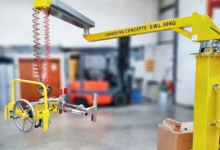How Welding Automation Is Revolutionizing Modern Manufacturing

Welding automation is revolutionizing modern manufacturing by combining advanced robotics with precision and efficiency. Traditional welding methods, while effective, often face challenges such as inconsistent quality, high labor costs, and workplace risks.
By automating these processes, businesses can achieve faster production cycles, improved safety, and superior consistency in every weld. In this article, we’ll explore how welding automation is transforming the manufacturing landscape and why it’s becoming an essential part of industrial growth.
Challenges of Traditional Welding
Traditional welding plays a key role in manufacturing, but it has several challenges that can impact quality, cost, and safety.
Inconsistent Quality
Manual welding relies on the skill of individual workers, which can vary. This can result in defects such as weak welds, gaps, or holes. Correcting these errors wastes time, materials, and can lower overall product quality.
High Labor Costs and Workforce Shortages
Many experienced welders are retiring, and there aren’t enough new workers to fill the gap. This makes it difficult for factories to meet demand while maintaining high standards. Robotic welding and automation reduce dependence on human labor while improving speed and accuracy.
Safety Risks
Welding exposes workers to intense heat, sparks, and harmful fumes, which can cause burns, respiratory issues, or long-term health problems. Robots can handle these dangerous tasks, keeping workers safe.
Slow Production and Bottlenecks
Manual welding is slower and requires frequent breaks, which can create production delays and higher costs. Automated welding systems operate continuously, speeding up production and increasing efficiency.
Robotic and automated welding addresses these challenges by improving consistency, reducing costs, enhancing safety, and accelerating production, making it a smart choice for modern manufacturing.
See also: Understanding Employee Tracking Technology
Benefits of Welding Automation
Welding automation brings many advantages to manufacturing, helping factories work faster, safer, and more efficiently.
Increased Productivity
Works Nonstop: Robots can operate all day and night without breaks, increasing production.
Faster Welding: Automated systems maintain consistent speed and accuracy, finishing tasks more quickly.
Consistent Quality
Precise and Reliable: Robots create high-quality, repeatable welds, reducing mistakes and the need for rework.
Less Human Error: Automation makes welds more uniform and products more consistent.
Cost Efficiency
Saves Labor Costs: Fewer workers are needed, which reduces long-term expenses.
Less Material Waste: Accurate robotic welding reduces material waste and lowers production costs.
Enhanced Safety
Protects Workers: Robots handle dangerous tasks, keeping humans away from heat, sparks, and harmful fumes.
Safer Workplaces: Automation lowers the risk of accidents and injuries.
Flexibility and Scalability
Versatile Welding: Automated systems can perform different types of welding, like MIG, TIG, and laser.
Easily Scaled: Production can be increased without needing more workers or extra time.
Welding automation improves productivity, quality, safety, and cost efficiency while offering flexibility for changing demands, helping manufacturers stay competitive.
Applications of Robotic Welding Across Industries
Robotic welding is commonly used in different industries to improve precision, efficiency, and safety.
Automotive Manufacturing
Robots are used to assemble car bodies, frames, and other components. They ensure consistent quality and speed, handling tasks like welding chassis, powertrains, and exhaust systems. This helps make vehicles stronger and safer.
Aerospace & Defense
In aerospace, robots weld important parts such as fuselages and wings, ensuring high precision and reliability. They are also used in defense equipment, where strong and durable welds are essential for safety and performance.
Heavy Machinery & Construction Equipment
Robotic welding is used to make large components like frames and structural parts. This ensures durable welds that can withstand tough conditions while increasing productivity and consistency.
Metal Fabrication & Shipbuilding
Robots weld metal parts with high accuracy, which is especially important in shipbuilding for creating strong and reliable structures. Automation also makes welding faster and more efficient.
Electronics & Precision Manufacturing
In electronics, robots weld delicate components like circuit boards and sensor housings. This ensures precise, reliable assembly, meeting the high-quality standards required for electronic devices and precision instruments.
Robotic welding is transforming manufacturing across industries by improving quality, reducing costs, and keeping workers safe.
Implementing Welding Automation
Integrating robotic welding into your manufacturing process requires careful planning. Key factors to consider include:
Assess Production Needs and ROI
Production Volume and Complexity: Determine if your production is large or repetitive enough to gain from automation. Robotic welding works best for high-volume tasks.
Return on Investment (ROI): Consider potential savings from reduced labor, fewer errors, and faster production cycles. Many companies recoup their investment within one to two years.
Infrastructure and Space
Ensure there is enough floor space for robots to move safely, handle materials, and allow workers to access the area. Plan an efficient facility layout with clear workflows for loading, unloading, inspections, and potential future expansions.
Operator Training and Programming
Provide comprehensive training so operators can safely operate, program, and troubleshoot robotic systems. Equip them with the skills to adjust robots for various welding tasks, ensuring flexible and efficient production.
Maintenance and Support
Regular maintenance and timely technical support keep robotic systems running reliably, prevent breakdowns, and minimize production downtime.
By carefully considering production needs, space, training, and maintenance, manufacturers can successfully implement welding automation, achieving higher productivity, consistent quality, and long-term cost savings.
How Robotics Drives Innovation in Welding
Robotic welding is transforming manufacturing by enhancing precision, efficiency, and flexibility. Here’s how robotics is leading the way:
Automating Complex Welding Tasks
Robots can perform complicated welding jobs, such as multi-layer welds and challenging joint shapes, with high accuracy. This minimizes human error and ensures consistent quality.
Integration with AI and IoT
Robotic welders leverage Artificial Intelligence (AI) and the Internet of Things (IoT) to optimize welding in real-time. Sensors collect data, AI analyzes it, and the system automatically adjusts settings, predicts maintenance needs, and adapts to production changes.
Data-Driven Process Optimization
Robots equipped with sensors collect production data that can be analyzed to identify patterns, detect issues, and improve efficiency. Over time, machine learning allows systems to perform better, reduce waste, and enable predictive maintenance.
Flexibility for Any Production Size
Modern robots and collaborative robots (cobots) can handle both small and large production runs. They can be reprogrammed for different welding tasks, providing manufacturers with the flexibility to adapt to changing demands.
Robotic welding enhances manufacturing by automating complex tasks, leveraging AI for smarter operations, and adapting to diverse production needs. It ensures consistent quality, accelerates production, and makes factories more efficient and dependable.







